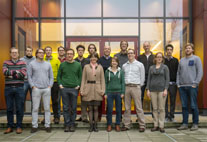Workshop on “Enhanced Weathering”: Using weathering to capture carbon dioxide
23 January 2014, by Markus Dressel

Photo: UHH/CEN
Enhanced weathering – turbo-weathering rocks is an innovative approach to capturing large amounts of the greenhouse gas carbon dioxide (CO2). At the same time...
Enhanced weathering – turbo-weathering rocks is an innovative approach to capturing large amounts of the greenhouse gas carbon dioxide (CO2). At the same time, the process produces substances that can be used as fertilizer. Leading experts in this comparatively new research field recently met in Hamburg for a workshop organized by Professor Jens Hartmann and his team at the Geological Institute. The topic merited an article in the current issue of Nature.
“We used the workshop for intensive networking, founding an international working group,” relates Prof. Jens Hartmann, a researcher at the Center for Earth System Research and Sustainability (CEN) whose research interests include the global carbon cycle. At the event, about 20 researchers from e.g. Los Angeles, Antwerp and Oxford came together for the first time to prepare a joint research agenda for the next few years, which will focus on questions like: How can powdered rock be used as an agricultural fertilizer? How much additional carbon can plants and soil capture through the fertilizer effect? What are the effects on various organisms when weathering products find their ways to rivers and seas, changing their pH levels? How can weathering be integrated into the global CO2 emissions certificate trading, so that it can be financed? “We need reliable numbers to answer all these questions,” explains Hartmann.
But how exactly does “enhanced weathering” work? When solid rock is exposed to weathering, it draws CO2 from the atmosphere through chemical reactions. The dissolved CO2 is transported by rivers to the ocean, effectively “disappearing” from the active carbon cycle for thousands of years. This naturally occurring but extremely slow process can be accelerated by processing suitable minerals, like those found in volcanic rock, into a fine rock flour, which is then spread over agricultural fields and the ocean. Upon contact with water, the powdered minerals dissolve, releasing plant nutrients like silicium in the process. The IPCC’s latest Assessment Report predicts that this method could be used to capture roughly a gigatonne of atmospheric carbon every year – and that number doesn’t even include the increased carbon absorption among plants thanks to the fertilizer effect.
